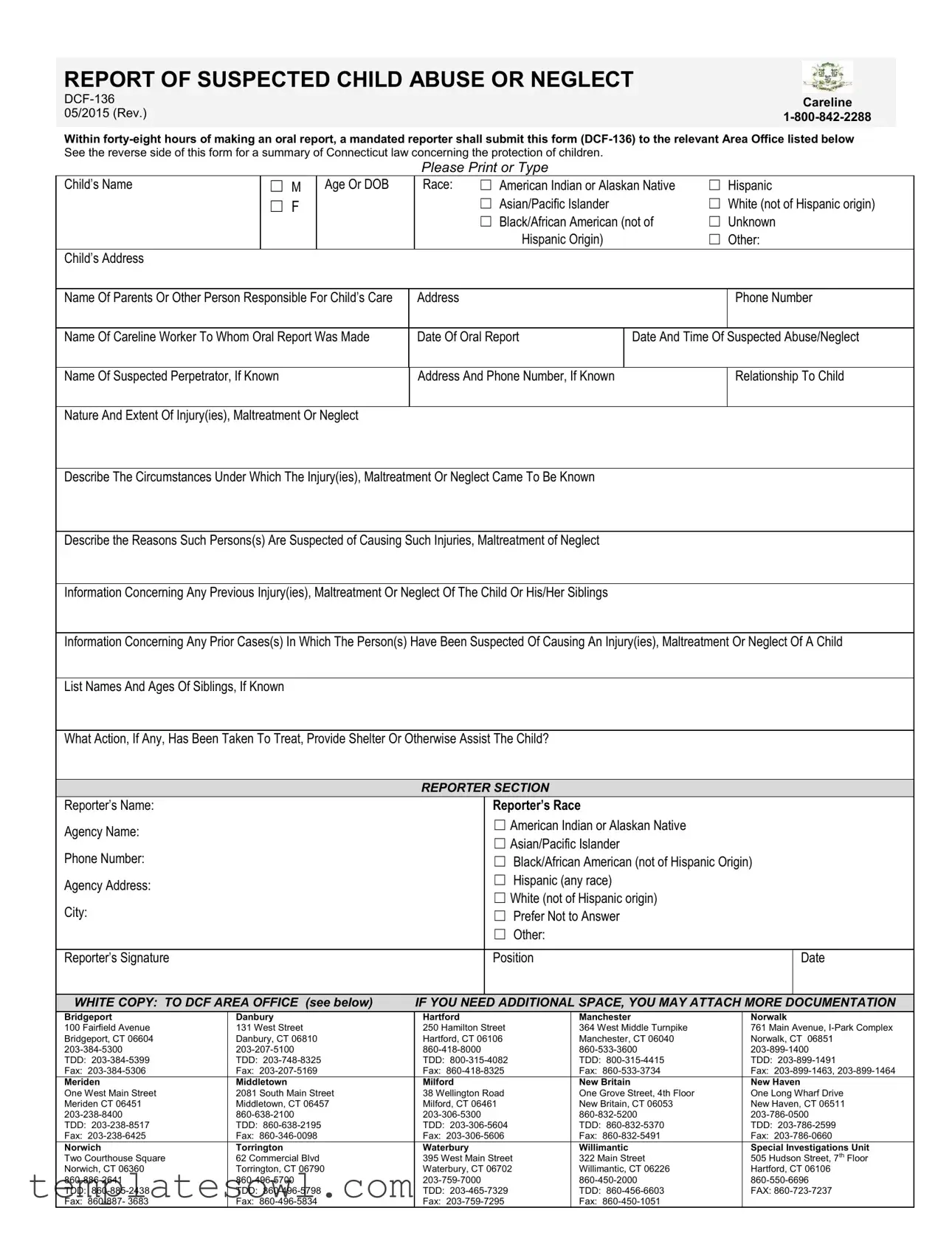SUMMARY OF LEGAL REQUIREMENTS CONCERNING CHILD ABUSE/ NEGLECT
PUBLIC POLICY OF THE STATE OF CONNECTICUT (C.G.S. §17a-101)
To protect children whose health and welfare may be adversely affected through injury and neglect; to strengthen the family and to make the home safe for children by enhancing the parental capacity for good child care; to provide a temporary or permanent nurturing and safe environment for children when necessary; and for these purposes to require the reporting of suspected child abuse or neglect, investigation of such reports by a social agency, and provision of services, where needed, to such child and family.
WHO IS MANDATED TO REPORT CHILD ABUSE/NEGLECT?
Child Advocate and OCA Employees |
Mental Health Professionals |
Chiropractors |
Optometrists |
Coaches and Directors of a Private Youth Sports, |
Persons Paid to Care for Children |
Organization or Team |
Persons who Provide Services to |
Coaches and Athletic Directors of Youth Athletics |
and have Regular Contact with |
Dental Hygienists |
Students |
Dentists |
Pharmacists |
Department of Children and Families Employees |
Physical Therapists |
Domestic Violence Counselors |
Physician Assistants |
Office of Early Childhood Employees and Department |
Podiatrists |
of Public health Employees who are Responsible |
Police Officers |
for Licensing Day Cares and Camps |
Probation Officers (Juvenile or Adult) |
Family Relations Counselors (Judicial Dept.) |
Psychologists |
Family Rel. Counselor Trainees (Judicial Dept.) |
Public or Private Institution of Higher |
Family Services Supervisors (Judicial Dept.) |
Education Administrators, Faculty, |
Licensed Foster Parents |
Staff, Athletic Directors, Athletic |
Licensed Marital and Family Therapists |
Coaches and Athletic Trainers |
Licensed or Unlicensed Interns at Any Hospital |
Registered Nurses |
Licensed or Unlicensed Resident Physicians |
School Administrators |
Licensed Physicians |
School Coaches |
Licensed Practical Nurses |
School Guidance Counselors |
Licensed Professional Counselors |
School Paraprofessionals |
Licensed Surgeons |
School Superintendents |
Licensed/Certified Alcohol and Drug Counselors |
School Teachers |
Licensed/Certified Emergency Medical Services Providers |
Sexual Assault Counselors |
Medical Examiners |
Social Workers |
Members of the Clergy |
Substitute Teachers |
DO THOSE MANDATED TO REPORT INCUR LIABILITY?
No. Any person, institution or agency which, in good faith, makes or does not make a report, shall be immune from any civil or criminal liability provided such person did not perpetrate or cause such abuse or neglect.
IS THERE A PENALTY FOR NOT REPORTING?
Yes. Any person required to report who fails to do so may be prosecuted for a Class A misdemeanor and may be required to participate in an educational and training program. Any person who intentionally and unreasonably interferes with or prevents a report may be prosecuted for a Class D felony.
IS THERE A PENALTY FOR MAKING A FALSE REPORT?
Yes. Any person who knowingly makes a false report of child abuse or neglect may be fined not more than $2,000 or imprisoned for not more than one year or both. The identity of such person shall be disclosed to the appropriate law enforcement agency and to the alleged perpetrator of the abuse.
WHAT ARE THE REPORTING REQUIREMENTS?
An oral report shall be made by a mandated reporter by telephone or in person to the DCF Careline or to a law enforcement agency as soon as practicable, but not later than 12 hours after the mandated reporter has reasonable cause to suspect or believe that a child has been abused or neglected or placed in imminent risk of serious harm. If a law enforcement agency receives an oral report, it shall immediately notify Careline. Oral reports to the Careline shall be recorded.
Within 48 hours of making an oral report, a mandated reporter shall submit a written report to the DCF Careline on the DCF-136, "Report of Suspected Child Abuse or Neglect."
When a mandated reporter is a member of the staff of a public or private institution or facility that provides care for children or a public or private school, the reporter shall also submit a copy of the written report to the person in charge of such institution, school or facility or the person's designee.
DCF CHILD ABUSE AND NEGLECT CARELINE: 1-800-842-2288
STATUTORY REFERENCES: C.G.S.17a-28, §17a-101 et seq.; §46b-120
DEFINITIONS OF ABUSE AND NEGLECT
Abused Child: Any child who has a non-accidental physical injury, or injuries which are at variance with the history given of such injuries, or is in a condition which is the result of maltreatment such as, but not limited to, malnutrition, sexual molestation, deprivation of necessities, emotional maltreatment or cruel punishment.
Neglected Child: Any child who has been abandoned or is being denied proper care and attention, physically, educationally, emotionally, or morally or is being permitted to live under conditions, circumstances or associations injurious to his or her well-being.
Exception: The treatment of any child by an accredited Christian Science practitioner shall not by itself constitute neglect or maltreatment.
CHILD UNDER AGE 13 WITH VENEREAL DISEASE: A physician or facility must report to Careline upon the consultation, examination or treatment for venereal disease of any child who has not reached his or her 13th birthday.
DO PRIVATE CITIZENS HAVE A RESPONSIBILITY FOR REPORTING?
Yes. Any person having reasonable cause to suspect or believe that any child under the age of 18 is in danger of being abused or has been abused or neglected may cause a written or oral report to be made to the Careline or a law enforcement agency. Any person making the report in good faith is immune from any liability, civil or criminal. However, the person is subject to the penalty for making a false claim.
WHAT IS THE AUTHORITY AND RESPONSIBILITY OF THE DEPARTMENT OF CHILDREN AND FAMILIES (DCF)?
All child protective services in Connecticut are the responsibility of the Department of Children and Families.
Upon the receipt of a report of child abuse or neglect, the Careline shall cause the report to be classified, evaluated immediately and forwarded to the appropriate Area Office for the commencement of an investigation or for the provision of services within timelines specified by statute and policy.
If an investigation produces evidence of child abuse or neglect, DCF shall take such measures as it deems necessary to protect the child, and any other children similarly situated, including,
but not limited to, immediate notification to the appropriate law enforcement agency, and the removal of the child from his or her home with or without the parents’ consent consistent with
state law.
If DCF has probable cause to believe that the child or any other child in the household is at
imminent risk of physical harm from the surroundings, and that immediate removal from such surroundings is necessary to ensure the child’s safety, the Commissioner or designee shall
authorize any employee of DCF or any law enforcement officer to remove the child and any other child similarly situated from such surroundings without the consent of the child’s parent or
guardian. The removal of a child shall not exceed 96 hours. If the child is not returned home within such 96-hour period, with or without protective services, DCF shall file a motion for temporary custody with the Superior Court for Juvenile Matters.
WHAT MEANS ARE AVAILABLE FOR REMOVING A CHILD FROM HIS OR HER HOME?
96-Hour hold by the Commissioner of DCF or designee (see above).
96-Hour hold by a physician – Any physician examining a child with respect to whom abuse or neglect is suspected shall have the right to keep such child in the custody of a hospital for no longer than 96 hours in order to perform diagnostic tests and procedures necessary
to the detection of child abuse or neglect and to provide necessary medical care with or without the consent of such child’s parents or guardian or other person responsible for the child’s care, provided the physician has made reasonable attempts to (1) advise such child’s parents or guardian or other person responsible for the child’s care that the physician suspects the child has been abused or neglected, and (2) obtain consent of such child’s parents or guardian or other person responsible for the child’s care. In addition, such
physician may take or cause to be taken photographs of the area of trauma visible on a child who is the subject of such report without the consent of such child’s parent’s or guardian or other person responsible for the child’s care. All such photographs or copies thereof shall be sent to the local police department and the Department of Children and Families.
Bench order of temporary custody – Whenever any person is arrested and charged with an offense under Section 53-20 or 53-21 or under Part V, VI, or VII of Chapter 952, as
amended, the victim of which offense was a minor residing with the defendant, any judge of the Superior Court may, if it appears that the child’s condition or circumstances surrounding the case so require, issue an order to the Commissioner of the Department of Children and Families to assume immediate custody of such child and, if the circumstances so require, any other children residing with the defendant and to proceed thereon as in other cases.
WHAT IS THE CENTRAL REGISTRY OF PERPETRATORS OF ABUSE OR NEGLECT? The Department of Children and Families maintains a registry of persons who have been substantiated as responsible for child abuse or neglect and pose a risk to the health safety or well-being of children. The Central Registry is available on a 24-hour daily basis to prevent or discover child abuse of children.

